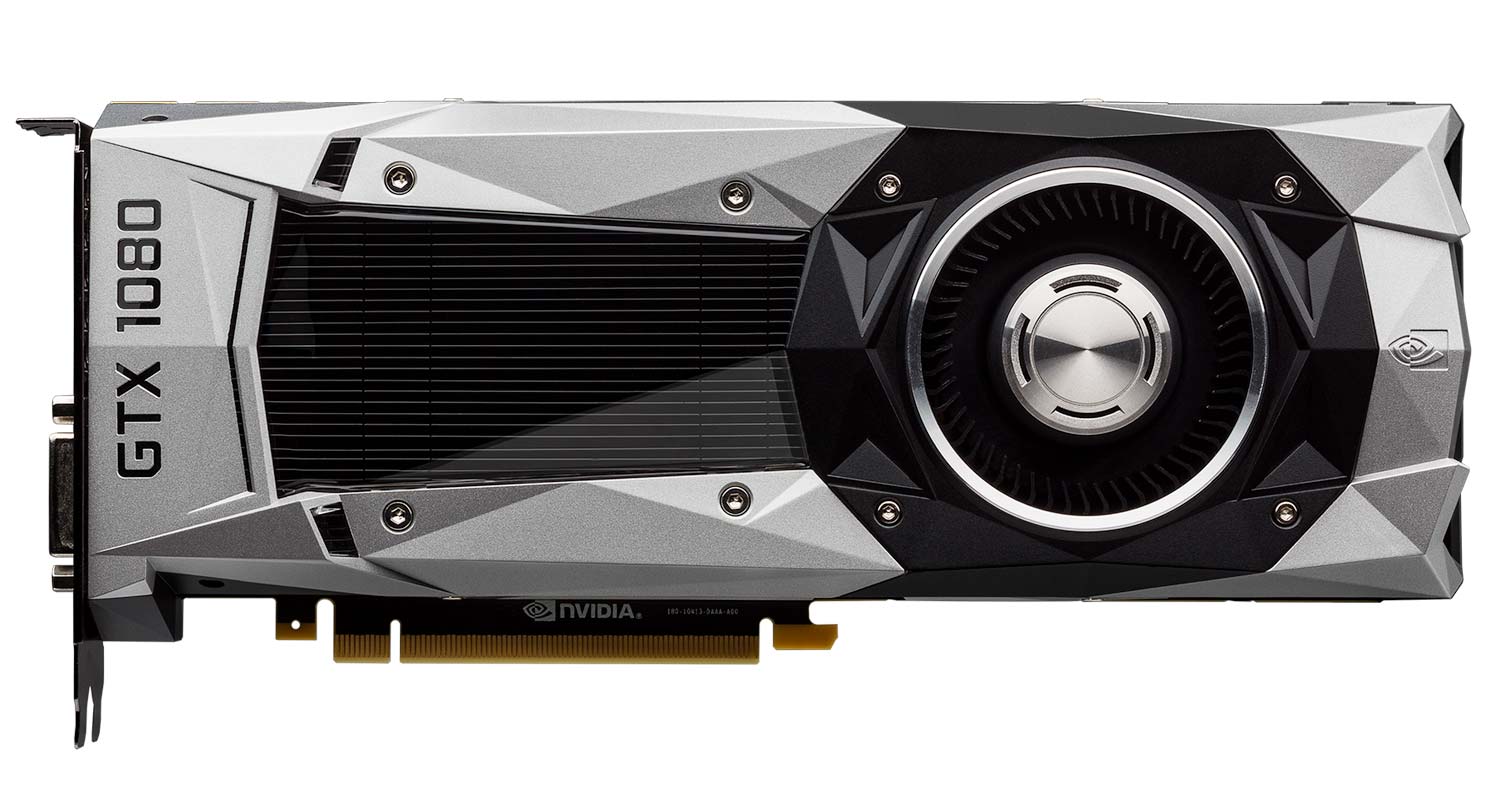Nvidia GeForce GTX 1080 Review: The Graphics Card to Beat
The Nvidia GeForce GTX 1080 graphics card offers extremely powerful performance for buttery-smooth gameplay at 4K.

Here's what I like about graphics cards: I get older, and they just get more powerful. This is especially true of the Nvidia GeForce GTX 1080. Priced at $699 (starting at $599), this component might just be the most powerful GPU on the market.
The first consumer-targeted card built on the company's Pascal architecture, the 1080 delivers incredibly smooth frame rates even at 4K. Even better, future updates promise big improvements to virtual reality and gaming overall. In short, if you want to supercharge your gaming experience, it's time to say hello to the 1080.

Design
The Founders Edition GTX 1080 looks like it's 5 seconds from transforming into a Mini-Con from the 1980s' "Transformers" cartoons. Nvidia got fancy for this graphics card, encasing a large portion of the component in sleek, silvery aluminum. Instead of the boring rectangular shape of previous cards, the GTX 1080 is flush with triangles that add to its "robots-in-disguise" look.

As with previous cards, the GTX 1080 has a large fan in the center of the device surrounded by a silver strip. The metal isn't just for show, as it makes up the vapor chamber cooler, which Nvidia claims will help keep the card cooler than a regular air-cooled card. That feature, combined with the more power-efficient components, is why the Founders Edition of the chip costs $100 more than the regular card.
For ports, the card offers a trio of DisplayPorts, a single HDMI port and a DVI port.
Setup
Swapping out the GTX 980 Ti card in our test rig was a quick and fairly painless process. After securing the new card into its PCIe slot with a single screw, I plugged in the power connector. Unlike previous cards that require two connectors, the 1080 needs just a single eight-pin power connector. Although our test bed had plenty of space to spare, you'll want to make sure that your desktop can accommodate the card, since it's a fairly large piece of hardware.
MORE: Best Gaming PCs
Sign up to get the BEST of Tom's Guide direct to your inbox.
Get instant access to breaking news, the hottest reviews, great deals and helpful tips.
Once I got the card up and running and downloaded a few Nvidia drivers, it was time to start benchmarking and, more importantly, play a crapload of games.
Pure Unmitigated Power
Nvidia really knocked it out of the park with this one. When I ran the synthetic 3DMark Fire Strike benchmark, the 1080 scored 17,852, torching the older GTX 980 Ti (15,269) and GTX 980 (12,704) by a wide margin at 1080p. The scores dropped significantly when I ran the test at 4K. However, the 1080 still came out on top, achieving 6,992, while the 980 Ti and 980 hit 4,187 and 3,048, respectively.

The 1080 continued its reign on Rise of the Tomb Raider, churning out 103 frames per second during the benchmark on high at 1080p, while the 980 Ti and 980 GPU hit 90 fps and 73 fps, respectively. When cranked up to 4K, the 1080's average frame rate fell to 50 fps. The 980 Ti hit 35 fps, which is just above our 30-fps playability threshold, while the regular 980 missed the mark, at 27 fps.
4K Graphics
As intriguing as running a bunch of benchmarks can be, the whole point of GTX 1080 is to play games at face-melting frame rates. I'm happy to report that the 1080 lives up to the hype and then some. Before I started playing Rise of the Tomb Raider, I made sure to turn every graphics setting up to its maximum level.
From there, I maneuvered Lara through a tense fight with a huge bear. The beast began its attack with a lunge, which Lara failed to dodge, placing the adventurer inches away from the animal's long, yellowed teeth. Lara freed herself by driving her trusty ax into the bear's side — all at a smooth 46 fps on 4K. What struck me most was how the individual strands of Lara Croft's hair floated through the air like delicate gossamer threads throughout the entire fight.
Speaking of flowing locks, Geralt's snow-white mane never looked prettier as he rode toward his next objective in The Witcher 3: The Wild Hunt. Even with Nvidia's resource-taxing (but oh-so-pretty) HairWorks software activated and the settings set to ultra at 4K resolution, the game ran at a buttery-smooth 40 fps. That meant that I could dodge, parry and let off a couple of fire spells to ward off a horde of Corpsers without experiencing any noticeable stuttering. When the fight was done, I took some time to admire the way the moonlight glinted off Geralt's armor.
Even with Nvidia's resource-taxing HairWorks software activated and the settings set to ultra at 4K resolution, The Witcher 3 ran at a buttery-smooth 40 fps.
The 1080 averaged 50 fps during Fallout 4 at 4K, which made for a much prettier Wasteland. This was particularly true when Boston's well-worn cobblestones gave way to hilly plains dotted with vegetation that were mutated vestiges of their former selves, but lovely nonetheless. The extra coat of polish also made those devastating V.A.T.S. kill shots all the more gruesome. Watching an enemy's head explode into a bloody mess has never looked so good.
MORE: How to Buy a Gaming Keyboard
At least that's what I thought until I fired up the new Doom. Running through the game while blasting demonic imps and other horrors was a sheer delight on the 1080 — especially once I got my hands on a chain saw and watched the weapon rip through a monstrous torso in an almost nauseating amount of detail. The game ran at an average 31 fps, which is playable, but I did notice a slight lag that forced me to dial back some of the superfluous effects, such as Motion Blur, to get a smoother frame rate.
Ansel and VRWorks
Gaming is more than shooting up the bad guys and earning that trophy. Look past all the chaos in some of your favorite games, and you might just find a world that's just as breathtaking as the destruction you levied a few seconds ago. With Ansel, the company's upcoming in-game photography technology, Nvidia wants to empower gamers to capture this beauty.
With Ansel, gamers can let their inner artist run free, capturing jaw-dropping beauty in stunning, super-high-resolution images of their favorite titles. Even better, the images can be captured from nearly any perspective in 360 degrees, allowing virtual-reality fans to view the shots with headsets such as Google Cardboardand the HTC Vive. When it launches, the technology will support a whole host of AAA titles, including The Witcher 3, Tom Clancy's The Division, Paragon, and Mirror's Edge Catalyst.
I'm happy to report that the 1080 lives up to the hype and then some.
The GeForce GTX 1080 graphics card will usher in a slew of technologies that will ultimately bring prettier games to both virtual reality and traditional 2D. The card's increased strength and more efficient power consumption mean that developers can potentially make the next big thing without blowing the budget on hardware.
The company's VRWorks software development kit lets developers take advantage of simultaneous multiprojection, which renders automatically for virtual reality. That delivers high resolutions for the center of the screen, where a person wearing a VR headset typically focuses. Nvidia will also roll out Nvidia VRWorks Audio and PhysX for VR software, which will bring spatial 3D audio, as well as better physics and touch interactivity, to virtual reality.
Bottom Line
The new GTX 1080 graphics card delivers a large step up in performance from previous GPUs, including the Titan X card. Starting at an aggressive $599 ($699 as reviewed), the 1080 card is capable of delivering smoking frame rates (even in 4K), and the upcoming Ansel software will allow gamers to capture the more artistic side of their favorite titles. The card will also usher in better graphics and immersion for VR users. Overall, if you're thinking about upgrading your desktop, the GTX 1080 delivers serious power at a lower starting price than its predecessors.
Sherri L. Smith has been cranking out product reviews for Laptopmag.com since 2011. In that time, she's reviewed more than her share of laptops, tablets, smartphones and everything in between. The resident gamer and audio junkie, Sherri was previously a managing editor for Black Web 2.0 and contributed to BET.Com and Popgadget.

